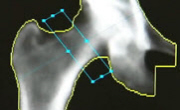Introduction: As long-term survival after kidney transplantation is possible, the incidence of medical complication among the kidney recipient increases. Osteoporosis is the one of common complication after kidney transplantation that causes profound ...
http://chineseinput.net/에서 pinyin(병음)방식으로 중국어를 변환할 수 있습니다.
변환된 중국어를 복사하여 사용하시면 됩니다.
- 中文 을 입력하시려면 zhongwen을 입력하시고 space를누르시면됩니다.
- 北京 을 입력하시려면 beijing을 입력하시고 space를 누르시면 됩니다.
신장 이식 수술 전 후 환자의 골밀도 검색과 이에 영향을 미치는 인자에 관한 연구 = Change of bone mineral density after kidney transplantation and factors influencing post-transplant bone mineral density loss
한글로보기https://www.riss.kr/link?id=T9719222
- 저자
-
발행사항
서울 : 연세대학교 보건대학원, 2005
-
학위논문사항
학위논문(석사) -- 연세대학교 보건대학원 , 역학및건강증진학과 , 2005.2
-
발행연도
2005
-
작성언어
한국어
- 주제어
-
발행국(도시)
서울
-
형태사항
vi, 56p. : 삽도 ; 26cm
-
일반주기명
지도교수: 지선하
- 소장기관
-
0
상세조회 -
0
다운로드
부가정보
다국어 초록 (Multilingual Abstract)
Introduction: As long-term survival after kidney transplantation is possible, the incidence of medical complication among the kidney recipient increases. Osteoporosis is the one of common complication after kidney transplantation that causes profound morbidity. Using the recipients with pre-transplant bone mineral density(BMD) data, post-transplant change of BMD was evaluated retrospectively. And this study analyzed the risk factors affecting the post-transplant BMD loss. Materials and Methods: Two hundred ninety four kidney transplant recipients from January 1996 to September 2003 were enrolled in this study. The BMD is expressed as the T-score of spine and femur. Gender, age, the presence of pre-transplant diabetes mellitus, the matching degree of ABO blood types, the mode and duration of dialysis, and the history of previous transplantation were considered as variables affecting the pre-transplant BMD and post-transplant BMD loss. Comparison analysis was performed by Student’s t-test or ANOVA. The variable that showed statistical difference (p-value<0.05) was considered as risk factor. Results: According to the pre-transplant BMD study, the mean of the spine T-score were significantly lower in the retransplant group. The mean femur T-score was significantly lower in the retransplant group, elderly recipients (more than 45 years) and female. Despite of steady bone loss for 3 years after transplantation, rapid bone loss occurred particularly in the post-transplant first year. The normal pre-transplant BMD group (T-score of spine and femur > -1.0) showed a significantly higher bone loss than abnormal pre-transplant BMD group (T-score of the spine or femur £ -1.0). According to the comparison analysis of BMD loss during post-transplant 1 year, prolonged pre-transplant hemodialysis (more than 60 months) and retransplant group were risk factors affecting the post-transplant BMD loss. In this study, ninety-eight recipient (33.3%) received anti-osteoporosis medication such as alfacalcidol, alendronate sodium, or risendronate sodium after renal transplantation. The early application of anti-osteoporosis management was effective in ameliorating the post-transplant BMD loss. However, anti-osteoporosis management after post-transplant 1 year was not effective. Conclusions: A pre-transplant evaluation of the BMD and the significant BMD loss during the first post-transplant year should not be overlooked. Prophylactic management against the bone loss should be encouraged in recipients with both a normal and abnormal pre-transplant BMD.
국문 초록 (Abstract)
연구 목적: 본 연구는 이식 전 후 골밀도의 변화양상을 파악하고, 이식 후 발생하는 골밀도 변화에 영향을 미치는 인자를 분석하는데 그 목적이 있다. 대상 및 방법: 연세대학교 세브란스 병...
연구 목적: 본 연구는 이식 전 후 골밀도의 변화양상을 파악하고, 이식 후 발생하는 골밀도 변화에 영향을 미치는 인자를 분석하는데 그 목적이 있다. 대상 및 방법: 연세대학교 세브란스 병원에서 1996년 1월부터 2003년 9월30일까지 신장이식 수술을 받은 환자 850명중 소아신장이식 환자, 타 장기와 동반이식 및 최근 6개월 내의 골절 경력이 있었던 환자를 제외하고, 신장이식수술 이전에 골밀도 검사를 시행 받고 이식 후 1년 이내에 1차례 이상 골밀도검사를 시행한 환자 294명을 대상으로 하였다. 골밀도 측정치는 요추부 및 대퇴부의 T-score를 대표값으로 사용하였으며, 군간의 평균값 비교는 Student’s t-test 혹은 ANOVA를 시행하였다. 이식 후 골밀도의 변화에 영향을 미치는 인자에 대한 통계학적인 검증은 다중회귀분석을 시행하여 유의수준 0.05 미만인 인자를 유의한 인자로 간주하였다. 연구 결과: 이식 전 시행한 골밀도 검사에 의하면 요추부 T-score는 재이식 군에서 유의하게 낮았으며, 대퇴부 T-score는 여성 수여자, 45세 이상의 수여자 및 재이식 군에서 유의하게 낮았다. 이식 후 3년간의 골밀도의 변화양상을 살펴보면 이식 후 1년 이내의 골밀도 손실이 가장 뚜렷하였다. 대퇴부보다는 요추부의 골밀도 감소가 상대적으로 뚜렷하였으나, 통계학적으로 유의한 수준은 아니었으며 변화양상은 비슷하였다. 이식 전 골밀도가 정상군(T-score>-1)의 이식 후 골밀도 감소량은 이식 전 골밀도 비정상군(T-score £ -1) 에 비하여 유의하게 높았다. 이식 후 1년 동안의 골밀도 변화에 미치는 인자를 단인자분석으로 확인해 본 결과 이식 전 투석의 기간이 긴 경우에서 초기 골밀도 손실이 많았으며, 재이식 군보다 일차이식 군에서의 골밀도 손실이 많았다. 이식 후 골밀도의 저하로 말미암아 294예의 환자 중 33.3 %에 해당하는 98예에서 골다공증 치료제의 투여가 필요하였다. Alfacalcidol 투여 예가 60 예로 제일 많았으며, alendronate sodium 31 예, risendronate sodium 7예의 순이었다. 이식초기부터 투여한 골다공증 치료는 이식 후 1년 동안의 골밀도 손실을 억제하였으나, 이식 후 1년이 경과된 이후에 투여 된 골다공증 치료제는 이 후의 골밀도에 유의한 영향을 미치지 못하였다. 결론: 이식 후 골밀도의 변화는 이식초기 1년에 가장 현저한 소실이 이루어지며, 골밀도의 손실이 이식 직후부터 투여된 골다공증 치료제에는 반응하나, 그 이후의 치료제 투여에는 유의하게 반응하지 못하였다. 따라서 이식환자에 대한 골다공증 치료는 이식 직후부터 바로 시작되어야 할 것으로 판단되며, 이식당시 골밀도 정상군도 고 위험 군처럼 지속적인 관찰과 예방이 장기적인 안목에서 필요할 것으로 생각된다.









